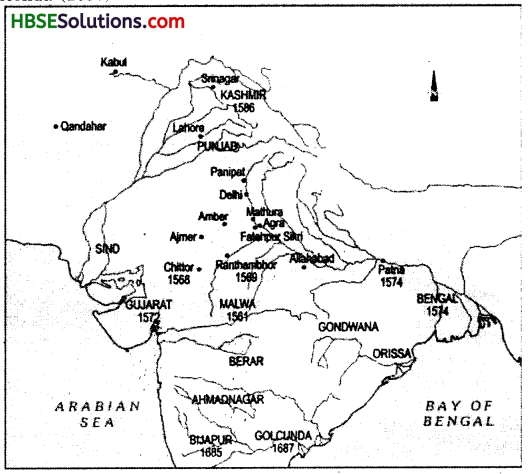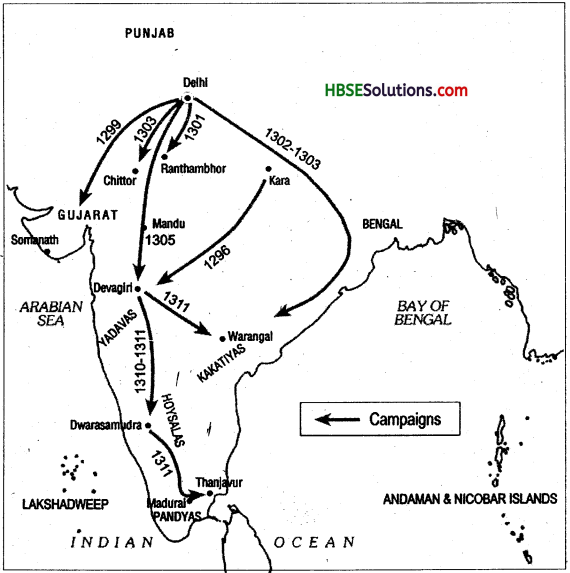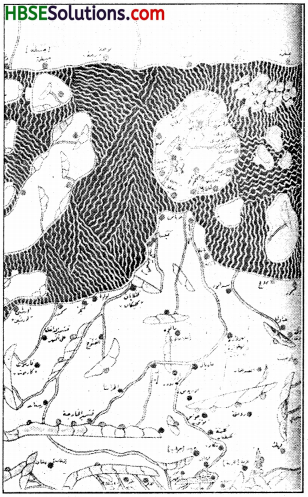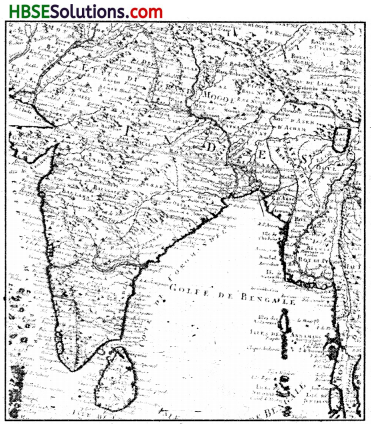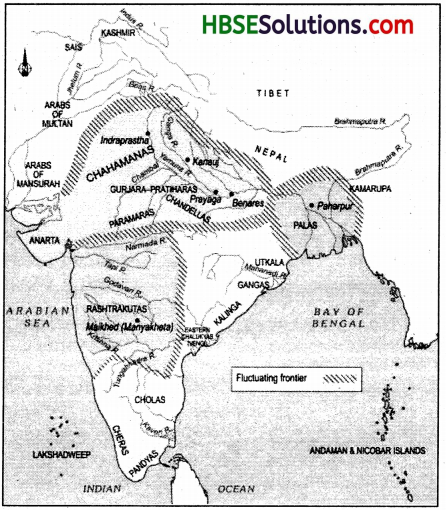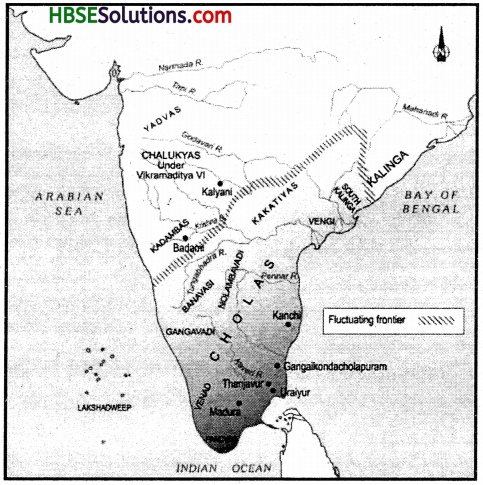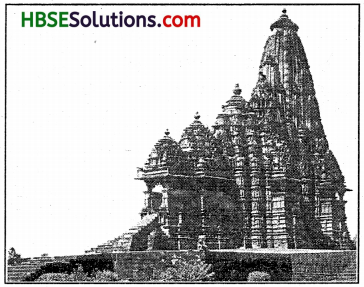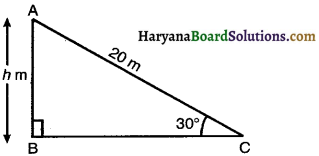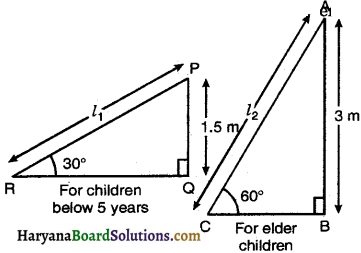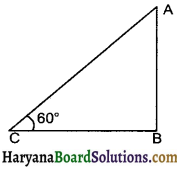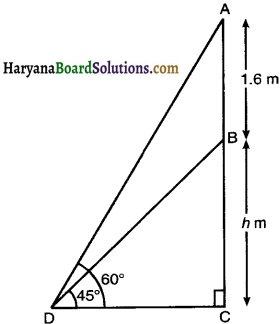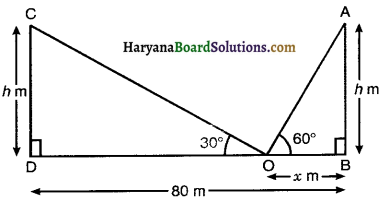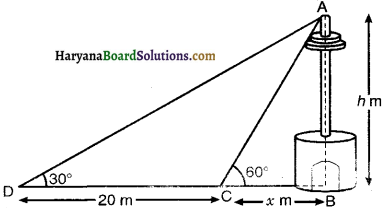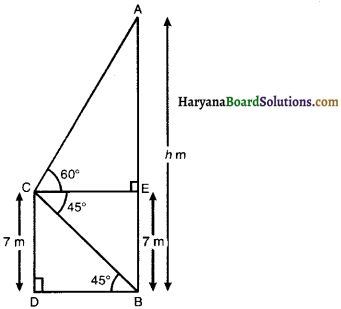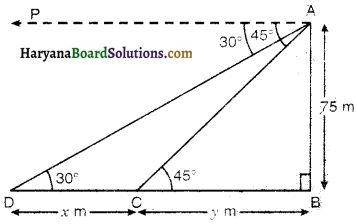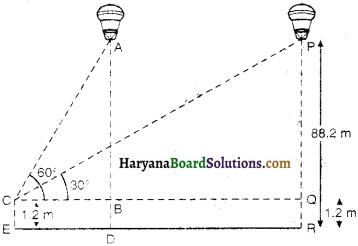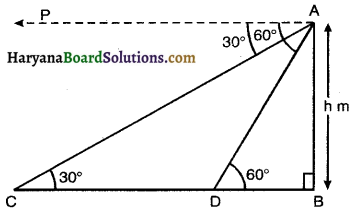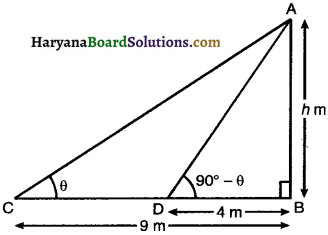HBSE 7th Class English Solutions Honeycomb Chapter 1 Three Questions
Haryana State Board HBSE 7th Class English Solutions Honeycomb Chapter 1 Three Questions Textbook Exercise Questions and Answers.
Haryana Board 7th Class English Solutions Honeycomb Chapter 1 Three Questions
HBSE 7th Class English Three Questions Textbook Questions and Answers
Comprehension Check
Three Questions 7th Class Question Answer Question 1.
Why did the king want to know answers to three questions?
Answer:
The king wanted to know answers to the three questions so that he would never fail.
Three Questions HBSE 7th Class Question Answer Question 2.
Messengers were sent throughout the kingdom
(i) to fetch wise men.
(ii) to find answers to the questions.
(iii) to look for the wise hermit.
(iv) to announce a reward for those who could answer the questions.
Mark your choice.
Answer:
(ii) to find answers to the questions.
![]()
Comprehension Check
Complete the following sentences by adding the appropriate parts of the sentences given in the box.
1. Many wise men answered the king’s questions,
2. Someone suggested that there should be a council of wise men
3. Someone else suggested that the king should have a timetable
4. The king requested the hermit
5. The lung washed and dressed the bearded man’s wound
- but the bleeding would not stop.
- to answer three questions.
- but their answers were so varied that the king was not satisfied.
- and follow it strictly.
- lo help the king act at the right time.
Answer:
1. but their answers were so varied that the king was not satisfied
2. to help the king act at the right time
3. and follow it strictly
4. to answer three questions
5. but the bleeding would not stop.
Working with The Text
Answer the following questions.
Question 1.
Why was the king advised to go the magicians?
Answer:
King was advised to go to magicians so that he could decided the right time for right thing.
Question 2.
In answer to the second question whose advice did the people say would be important to the king?
Answer:
To answer the second question the advice of councillors, doctors and priests would be important.
Question 3.
What suggestions were made in answer to the third question?
Answer:
Different suggestions were made in answer to the third question. The most important thing was suggested to be science, fighting and religious worship.
Question 4.
Did the wise men win the reward? If not, why?
Answer:
No, the wise men did not win the reward. The wise men did not win the award because they gave different answer to his questions.
Question 5.
How did the king and the hermit help the wounded man?
Answer:
The wounded man was bleeding heavily from hisstomach.The king and the hermit removed the man’s clothing. The king washed the wound and re-dressed it till the blood stopped flowing.
![]()
Question 6.
(a) Who was the bearded naan?
Answer:
The bearded man was the enemy of the king.
(b) Why did he ask for the king’s forgiveness?
Answer:
He had sworn revenge on the king. But the king had saved the life of the bearded man. So he asked for the king’s forgiveness.
Question 7.
The king forgave the bearded man. What did he do to show his forgiveness?
Answer:
The king forgave the bearded man. He was happy to have made peace with the man. To show his forgiveness, the king promised to send his servants and doctor to look after him. He also promised to return his property.
Question 8.
What were the hermit’s answers to the three questions? Write each answer separately. Which answer do you like most, and why?
Answer:
The hermit was a wise man. He answered all the questions in a witty manner. To the first question hermit replied that the most important time was when the king was digging the bed. A little later the most important time was when the king was taking care of the hermit.
For the second question hermit replied that he should listen to the person he was with at the particular moment. The hermit, replied that the most important work to do was to do good to the person, you are with.
The third answer is the most important answer. If we do the person good then our time would be also right to begin.
HBSE 7th Class English Three Questions Important Questions and Answers
Very Short Answer Type Questions
Question 1.
What thought come to the kings mind?
Answer:
The king thought that he would never fail if he knew about three things.
Question 2.
What did king do to get answers to the questions?
Answer:
The king sent messengers throughout his kingdom and promised a large sum of money to anyone who answered.
Question 3.
How would making of the timetable help the king?
Answer:
The king could follow the timetable strictly and do everything at the right time.
Question 4.
How could urgent matters be decided by the king?
Answer:
The urgent things could not be decided by the council. The king had to go to the magicians to look into future.
Question 5.
Which people would most be needed to answer the second question?
Answer:
The people most needed were councillors, priest, doctors and soldiers.
Question 6.
Why did the king go to hermit?
Answer:
The king went to the hermit for the advice as he had got no satisfactory answers of questions.
Question 7.
Why did the king put on simple clothes?
Answer:
The king put on simple clothes because he went to see the hermit. The hermit saw no one but simple people.
Question 8.
How did the hermit react on meeting the king?
Answer:
Hermit greeted the king but continued digging. He did not speak.
![]()
Question 9.
How did king take care of the fearded man?
Answer:
King redressed the wound of the bearded man. The king carried the fearded man to the bed and gave him fresh water.
Question 10.
What was the cause of enmity of the bearded man with the king?
Answer:
The king had put his brothers to death and seized his property.
Question 11.
What plan had bearded man made to kill the king?
Answer:
The bearded man had seen the king go alone to see the hermit. lie had planned to kill the king on his way back home.
Question 12.
What was the most important time according to the hermit?
Answer:
The hermit found that the most important time was when the king was digging the beds.
Short Answer Type Questions
Question 1.
What were the three things that the king was curious to know?
Answer:
The king was curious to know three things. He wanted to know the right time to begin something, which people should he listen to and what is most important thing to do.
Question 2.
What were the different suggestions given by the countrymen to the king?
Answer:
The countrymen wanted that he should avoid foolish pleasures, lie should do what seemed necessary. King could take advice of the council of men.
Question 3.
How did the king react to the suggestions of the countrymen?
Answer:
The king was not satisfied with the countrymen’s answers as the answers were very different. He decided to seek the advice of a certain hermit. The hermit was known for wisdom.
Question 4.
Describe the first meeting of the king with the hermit.
Answer:
The king went to meet the hermit in ordinary clothes. The king went to him alone. The hermit greeted the king and continued digging. The hermit listened to the three questions of the king. He did not speak.
![]()
Question 5.
How did the king behave with bearded man?
Answer:
The king behaved very gently with the bearded man. The king re-dressed the wound until bleeding stopped. The king carried the wounded man into the hut. The king also promised to send his servants and doctor to look after him.
Question 6.
Why did hermit think that the most important time was when the man ran to them?
Answer:
When the bearded man ran towards them it was the most important time. It was so because if king had not dressed his wounds, the man would have died. Then king would not have been able to make peace.
Question 7.
Who is the most wise person in the story? Justify.
Answer:
Hermit is the most wise person in the story. He was able to satisfy the king with his explanation. The king understood that most important time was ‘now’. It was the time when one had power to act.
Some Other Questions For Examination
Question 1.
Why did the king send messengers throughout his kingdom?
Answer:
The king sent messengers throughout his kingdom to spread the inessage that a large sum of money would be given to the person who would answer the king’s questions.
Question 2.
What do you know about the hermit from the story?
Answer:
The hermit lived in a wood which he never left. lie was a very wise hermit. He was kind and helpful. He helped the injured man in trouble. He satisfied the king with his answers. His answers related to the practical situations in life.
Question 3.
Why is it necessary to look into the future?
Answer:
Certain things are very urgent. They cannot wait for the council’s decision. Therefore, it is necessary to look into the future to decide the right time.
Question 4.
What made the bearded man turn lrom the king’s enemy to his friend?
Answer:
The bearded man had come to’ take revenge from the king and wanted to kill the king. However, the king’s guard had wounded him. He came running towards the hermit’s hut. The king and the hermit washed his wound and helped the injured man to recover from the injury. He was overwhelmed with king’s generosity. So he asked forgiveness from the king and became his friend.
![]()
Multiple Choice Questions (MCQ)
Tick (✓) the correct option.
Question 1.
Which of the following statements is wrong?
(a) The king wanted answers to four questions.
(b) Many wisemen came to the king.
(c) The king promised a large sum of money to anyone who would answer his questions.
(d) Some suggested that the king should notice all that was going on, avoid foolish pleasures always do whatever seemed neessary at that time.
Answer:
(a) The king wanted answers to four questions. ✓
Question 2.
Which word means-‘a group of people chosen to give advice or to make rules’?
(a) Councillor
(b) Council
(c) Loods
(d) Affairs
Answer:
(b) Council ✓
Question 3.
What does the word ‘affairs’ mean?
(a) things
(b) matters
(c) business
(d) either of these
Answer:
(d) either of these ✓
Question 4.
When the king came near the hermit’s hut,
(a) the hermit was sleeping.
(b) the hermit was digging the ground in front of his hut.
(c) the hermit was meditating.
(d) the hermit was punishing a man.
Answer:
(b) the hermit was digging the ground in front of his hut. ✓
![]()
Question 5.
Who said this to whom? “Let me take the spade and work in your place.”
(а) The hermit said this to the king.
(b) The king said this to the hermit.
(c) The bearded man said this to the king.
(d) The councillor said this to the king.
Answer:
(b) The king said this to the hermit. ✓
Make Sentences
Use the following words in sentences of your own.
(i) tired
(ii) decision
(iii) wounded
(iv) important
Answer:
Sentences:
(i) Tired: After day’s hard work, the tired labourer had his simple meal.
(ii) Decision: I took a decision that I will go abroad for further studies.
(iii) Wounded: The doctor healed the wounded man by applying antiseptic cream.
(iv) Important: Management of time and money is most important in every business.
Three Questions Passages for Comprehension
Read the passages carefully and answer the questions that follow:
Passage – 1
The king ………….. these questions.
Questions:
(i) Name the lesson.
(ii) Why were the messengers sent throughout his kingdom?
(iii) I Tow many questions were to he answered?
(iv) What was promised to be given
Answers:
(i) The name of the lesson is ‘Three Questions’.
(ii) The messengers were sent to find answer to the questions.
(iii) Three questions were to the answered.
(iv) A large sum of money was promised to be given.
Passage – 2
These things ………….. the future.
Questions:
(i) What does ‘these things’ refer to?
(iij Who formed the council?
(iii) How could one look into future?
(iv) Give the antonym of the word future?
Answers:
(i) These things refer to urgent matters.
(ii) The wise men formed the council.
(iii) One could look into the future with help of magicians
(iv) Future – Past.
![]()
Passage – 3
As the …………… his wisdom.
Questions:
(i) Why was the king not satisfied?
(ii) Choose a word which means same as ‘gift’.
(iii) What did king decide to do?
(iv) What was the hermit known for?
Answers:
(i) King got very different answers to all the questions.
(ii) Reward.
(Hi) The king decided to seek advice of a hermit.
(iv) Hermit was widely famous for his wisdom.
Passage – 4
As the king ………….. breathed heavily.
Questions:
(i) Why did the king go to the hermit?
(ii) What was the hermit doing?
(iii) Name two characteristics of the hermit.
(iv) Write the opposite of‘continued’.
Answers:
(i) The king went to the hermit to get the answers to his questions.
(ii) The hermit was digging the ground in front of his hut.
(iii) The hermit was old and weak.
(iv) Stopped.
Passage – 5
The king ………………. the ground.
Questions:
(i) Whom did the king see on turning?
(ii) What was the reason of flowing of blood?
(iii) How did the king help the bearded man?
(iv) Choose word which means unconscious.
Answers:
(i) On turning the king saw a bearded man running towards them.
(ii) The bearded man had been attacked by the king’s bodyguards.
(iii) The king dressed the wound of the bearded man.
(iv) Fainted.
![]()
Three Questions Translation in Hindi
Before you read:
Aking has ……………………… what he wants?
एक राजा के पास तीन प्रश्न हैं और वह उनके जवाब ढूँढ रहा है। ये प्रश्न क्या हैं? क्या राजा को वह मिलता है जो वह चाहता है?
I
1. The thought …………………….. him todo?
किसी राजा के मन में यह विचार आया कि वह कभी असफल नहीं होगा अगर वह तीन बातें जानता। यह तीन बातें थीं, कुछ भी आरंभ करने का सही समय क्या है? किन लोगों को वह सुन? उसके लिए करने के लिए सबसे महत्त्वपूर्ण चीज क्या है?
Word Meaning: Thought-idea = विचार, Certain-anyperson = कोई, Fail-unsuccessful = असफल होना, Begin-to start = आरंभ, Importantsignificant = महत्वपूर्ण।
2. The king………………….these questions.
राजा ने, इसलिए पूरे राज्य में संदेशवाहक इस आश्वासन से भेजे कि जो इन प्रश्नों का जवाब देगा उसे बहुत बड़ी नराशि दी जायेगी।
Word Meaning: Therefore-80 = इसलिए, Throughout-everyplace = हर जगह, Kingdomroyal state = साम्राज्या
3. Many wise………….. ………… differently.
कई बुद्धिमान व्यक्ति राजा के पास आए. पर उन सबने प्रश्नों का उत्तर भिन्न प्रकार से दिया।
Word Meaning: Wise-learned = 16 r. Differently-inadifferent manner = भिन्न प्रकार से।
4. In reply ………………………… something.
पहले प्रश्न के जवाब में कुछ ने कहा कि राजा को समय-सारणी बनाकर दृढ़ता से उसका अनुकरण करना चाहिए। सिर्फ इसी तरह, उन्होंने कहा कि वह हर चीज उचित समय पर कर सकता है। दूसरों ने कहा कि पहले से कुछ करने के उचित | समय का निर्णय करना असंभव था।
Word Meaning:
Reply-answer = 294, Prepare-tomake = बनाना, Time table-table of distribution of work and periods = समय-सारणी, Follow-togo or come after = अनुकरण करना, Strictly-rigid = दृढ़ता से, Impossible-not possible = असंभव. Advance-to supply before hand = पेशगी, अग्रिम
![]()
5. The king ……………………… proper time.
राजा को जो सब हो रहा है उस पर ध्यान देना (चाहिए। मूर्खता से भरपूर खुशियों को टालना (चाहिए) और हमेशा वही करना चाहिए जो उस समय पर महत्त्वपूर्ण लगे। फिर भी दूसरों ने कहा कि राजा को बुद्धिमान की एक परिषद की जरूरत है जो काम को सही समय पर करने में सहायक होंगे।
Word Meaning: Notice-to observe = ध्यान देना, Avoid-to escape = टालना, Pleasureshappiness = खुशियाँ, Necessary-important = महत्त्वपूर्ण, Council-advisory = परिषद, WiseVearned = बुद्धिमान।
6. This was ……………………. every action.
यह इसलिए था क्योंकि एक आदमी बिना दूसरों की सहायता के और हर कार्य को सही समय पर करने का निर्णय नहीं ले पाएगा।
Word Meaning: Imposible-not possible = असंभव, Decide-to make a decision = निर्णय लेना, Action-performance = कार्य।
7. But then ……………………… the council.
पर तब दूसरों ने कहा कि कुछ ऐसी बातें थीं जो बहुत जरूरी हो सकती थीं। ये बातें परिषद के फैसले का इंतजार नहीं कर सकती थीं।
Word Meaning: Urgent-very necessary = बहुत जरूरी, Decision-judgment = पेसला. Couneil advisory = परिषद।
8. In order ………………………lo magicians.
सही समय पर कुछ करने का फैसला करने से पहले भविष्य के बारे में सोचना बहुत जरूरी है। और जादूगर ही यह कर सकते हैं। राजा को इसलिए जादूगरों के पास जाना पड़ेगा।
Word Meaning: Decide-to take u decision = फैसला लेना। Future-time to come = भविष्य काल, Magicians-Wizard = जादूगर, Therefore-80 = इसलिए।
9. In their ………………….. most necessary.
उसके (राजा के) दूसरे प्रश्न के जवाब में कुछ ने कहा कि राजा के लिए सबसे महत्त्वपूर्ण लोग उसके सलाहकार हैं। दूसरों ने कहा, पुजारी। कुछ ने डाक्टर का चयन किया। और फिर दूसरों ने कहा कि सिपाही सबसे महत्त्वपूर्ण हैं।
Word Meaning: Councillors-members of the council = सलाहकार, Priest-man performing holy rites = पुजारी, Soldiers-Warriors = सिपाही।
10. To the ………………. religious worship.
तीसरे प्रश्न के जवाब में कुछ ने कहा विज्ञान। दूसरों ने युद्ध का चयन किया, और तथापि दूसरों ने धार्मिक पूजा (का चयन किया)।
Word Meaning: Fightiny-lo set to fight = युद्ध करना. Yel-Still = तथापि, Religious-relating to religion = धार्मिक, Worship-topray = पूजा।
11.As the…………………………. his wisdom.
जैसा कि सारे प्रश्नों के उत्तर बहुत भिन्न थे. इसलिए राजा संतुष्ट न हुआ और उसने काई इनाम नहीं दिया। बदले में उसन किसी तपस्वी की सलाह मांगन की साची जा अपनी बुद्धिमत्ता के लिए प्रसिद्ध था।
Word Meaning: Different-not same = अलग, Satisfied-content = संतुष्ट, Reward-Tetribution = पारितोषिक, Instead-in place of = बदले में, Seek-to ask for = माँगना, llermit-a recluse = तपस्वी. Famous-twell-known = प्रसिद्ध, Wisdom-knowledge = बुद्धिमानी।
![]()
12. The hermit…………………….. on alone.
तपस्वी एक जंगल में रहता था जिसे उसने कभी नहीं छोड़ा था। वह सिर्फ साधारण लोगों के अलावा किसी को नहीं देखता था इसलिए राजा ने साधारण कपड़े पहन लिए। तपस्वी की कुटिया में पहुँचने से पहले राजा अपना घोड़ा अपने अंगरक्षक के पास छोड़कर अकेला चला गया।
Word Meaning: Wood-forest = जंगल, Simple-ordinary = साधारण, Hut-cottage= कुटिया, Bodyguard-one who were king’s soldiers = अंगरक्षक।
13.As the ………………… breathed heavily.
जैसे ही राजा तपस्वी की कुटिया के पास आया, उसने तपस्वी को कुटिया के बाहर भूमि को खोदतं पाया। उसने राजा का अभिवादन किया और लगातार खोदता रहा। तपस्वी बूढ़ा और कमजोर था। और काम करते समय वह मुश्किल से सांस ले पा रहा था।
Word Meaning: Digging-lo hollow out by digging = खोदाई. Ground the surface of land = भूमि, Greeted to compliment = अभिवादन करना, Continued-not stop = लगातार, Breathed heavily-to breathe with difficulty = मुश्किल से सांस लेना।
14. The king …………….. most important?
राजा तपस्वी के पास गया और कहा, “बुद्धिमान तपस्वी में तुम्हारे पास तीन प्रश्नों के जवाब पूछने आया हूँ: मैं सही समय पर सही चीज करना कैसे सीख सकता हूँ? वह कौन से लोग हैं जिनकी मुझे बहुत जरूरत है? और कौन से कार्य सबसे महत्त्वपूर्ण हैं?”
Word Meaning: Affairs-twork = कार्य।
15. The hermit ………………… your place.”
तपस्वी ने राजा की बात को ध्यान से सुना पर कुछ भी नहीं बोला. वह खोदता रहा। “तुम थक गए हो”. राजा ने कहा। “मुझे तुम्हारा फावड़ा लेकर तुम्हारी जगह पर काम करने दो”।
Word Meaning: Listened-to hear with attention = ध्यान से सुनना, Tired- wearry = थका हुआ, Spade-a shovel= फावड़ा।
16. “Thanks,” said …………….. the ground.
“धन्यवाद”, तपस्वी ने राजा को फावड़ा देते हुए कहा। फिर वह भूमि पर बैठ गया।
17. When the …….. ……… me work.”
जब राजा ने दो क्यारियाँ खोद ली तो उसने रुककर अपने प्रश्न दुहराए। तपस्वी ने कोई जवाब नहीं दिया, पर खड़े होकर अपना हाथ फावड़े के लिए फैलाते हुए कहा, अब “तुम आराम करो और मुझे काम करने दो।”
Word Meaning: Dug-to hollow out by digging = खोदना, Bed-aplot of ground for plants = पौधों की क्यारी, Repeated-to say again – दुहराना, Stretching-to extenil = फैलाते हुए।
18. But the ……. to dig.
पर राजा ने उसे फावड़ा नहीं दिया और खोदता रहा।
19.One hour ……………….. returm home.”
एक घंटा व्यतीत हुआ, और फिर दूसरा। सूर्य पेड़ों के पीछे छिप गया, और आखिर में राजा नं फावड़े को भूमि में रखा (पटका) और कहा, “बुद्धिमान व्यक्ति मैं तुम्हारे पास अपने प्रश्नों के जवाब के लिए आया हूँ। अगर तुम मुझे कोई उत्तर नहीं दे सकते, तो मुझे बता दो और मैं वापिस चला जाऊँगा।”
Word Meaning: Stuck-to fasten = खाँसना, Sun went down-setting of sun = सूर्यास्त हो गया।
20. “Here comes ……………….. the hermit.
“यहाँ पर कोई दौड़ता आ रहा है।”, तपस्वी ने कहा।
![]()
II
21.The king ……………………. his stomach.
राजा मुड़ा और उसने एक ढाढ़ी वाले व्यक्ति को उनकी तरफ दौड़ते हुए आते देखा। उसने अपने पेट को हाथों से दबाया हुआ था जिसमें से खून बह रहा था। जब वह राजा के पास पहुँचा तो वह बेहोश होकर भूमि पर गिर गया। राजा और तपस्वी ने उस व्यक्ति के कपड़े उतारे और उसके पेट में बहुत बड़ा जख्म पाया।
Word Meaning: Turned round-to turn on one side = पीछे मुड़कर देखना, Bearded-hair on face = दाढ़ीवाला, Towards-in their direction = उनकी तरफ, Blood was flowing-oozing out of blood – खून का बहना, fainted-unconscious = मूर्छित, बेहोश Wound-sore = जख्म।
22. The king …………………………… to him.
राजा ने जख्म को धोकर अपने रूमाल से ढक दिया। खून बहना रुक नहीं रहा था। राजा ने फिर दुबारा से जख्म की मरहम-पट्टी की जब तक कि खून बहना बंद नहीं हुआ। (अब) उस व्यक्ति ने राहत महसूस की और कुछ पीने को माँगा। राजा ने ताजा पानी लाकर उसे दिया।.
Word Meaning: Handkerchief-a small piece of cloth = रूमाल, Flowing-torun as = बहाव, Re-dressed to again re-dress the twound = दुबारा से मरहम-पट्टी करना। Fresh-new = ताजा।
23. By this ………… lay quiet. इस समय तक सूरज अस्त हो गया और हवा शीतल थी। राजा तपस्वी की सहायता से जख्मी व्यक्ति को कुटिया में ले गया और उसे पलंग पर लिटाया। वह
व्यक्ति आँखें बंद करके चुपचाप लेट गया।
![]()
Word Meaning: Cool-moderately cold = शीतल, Wounded-one who had been hurt badly = जख्मी, Laid him-put down = लिटाना, Quietsilently = चुपचापा
24. The king……………………… was awake.
राजा चलने और काम करने से थक गया था। वह फर्श पर __ लेट गया और पूरी रात सोया रहा। जागने के कुछ मिनट के बाद
उसे याद आया कि वह कहाँ था और पलंग पर लेटा हुआ दाढ़ीवाला – अजीब व्यक्ति कौन था। “मुझे माफ कर दो!” दाढ़ीवाले व्यक्ति ‘ने दबी आवाज में कहा, जब उसने देखा कि राजा जाग चुका था।
Word Meaning: Tired overworked = थका हुआ, Awoke-towake up = जागना. Remembertry to bring to memory = याद करना, Strangeindifferent = अजीब। Forgive me-to ask for excuse = माफी मांगना, Weak-Peeble = दबी हुई. Awake-toget up from sleep = जागना।
25. “Ido ……………………. the king.
“मैं तुम्हें नहीं जानता और तुम्हें किसलिए माफ करूं”, राजा ने कहा।
26. “You do.. ………… way home.
“तुम मुझे नहीं जानते, पर मैं तुम्हें जानता हूँ। मैं तुम्हारा वह दुश्मन हूँ जिसने तुम से बदला लेने की कसम खाई थी क्योंकि तुमने मेरे भाई को मौत के घाट उतारा था और मेरी संपत्ति हथिया
ली थी। मुझे मालूम था कि तुम उस तपस्वी से अकेले मिलने गए थे और मैंने रास्ते में तुम्हें घर जाते हुए मारने का निश्चय कर लिया था।
Word Meaning: Enemy-hostile = शशु. Swore-to take a vow = 14. Revenge-to retaliate = बदला लेना, Seized to take away forcefully = छीन लेना. Property-ownership = संपत्ति जायदाद।
27. But the …………………….. my wounds.
पर दिन गुजर गया और तुम वापिस नहीं आए। इसलिए मैंने अपना छुपने का स्थान छोड़ा और तुम्हारे अंगरक्षक से टकरा गया, उसने मुझे पहचान लिया और मुझे जख्मी कर दिया। मैं वहाँ से भाग गया पर अगर तुम मेरे जख्मों की पट्टी नहीं करते तो मैं मर जाता।
Word Meaning: Hiding-place-a place where you can hide = छिपने का स्थान, Recognisedto identify = पहचानना, Escaped-toget free = भाग जाना, Dressed my wounds-to take care of one’s wounds = मरहम-पट्टी करना।
28. I wished ……………………. Forgive me!”
मुझे तुम्हें मारने की इच्छा थी और तुमने मेरी जिन्दगी बचाई है। अब अगर मैं जीवित रहूँगा तो मैं तुम्हारा आज्ञाकारी नौकर बन कर सेवा करूंगा और अपने बेटों को भी ऐसा करने को कहूँगा। मुझे माफ कर दो।”
Word Meaning: Wished–an eager desire = इच्छा, Faith-honest = आज्ञाकारी, Forgive meask for excuse = माफी माँगना।
![]()
29. The king …………………… his questions.
राजा बहुत खुश हुआ कि उसने अपने दुश्मन के साथ इतनी जल्दी शांति कायम कर ली और उसे दोस्त की तरह जीत लिया था। उसने न तो केवल उसे माफ किया अपितु कहा कि वह अपने नौकरों और डाक्टर को उसकी देखरेख के लिए भेज देगा और उसने उस व्यक्ति को उसकी जायदाद वापस करने का वचन दिया। जख्मी व्यक्ति को छोड़कर राजा झोपड़ी से बाहर निकला और तपस्वी को चारों तरफ ढूँढने लगा। जाने से पहले उसने अपने प्रश्नों के उत्तर जानने की इच्छा प्रकट की।
Word Meaning: Peace-cordial relations = शांति, Forgave-to excuse= माफ करना। Wished-to hope for = इच्छा ।
30. The hermit………………… wise man.
तपस्वी अपने घुटनों के सहारे क्यारी में बीज बो रहा था जो कि एक दिन पहले खोदी गई थी। राजा ने तपस्वी के पास जाकर कहा, “आखिरी बार मैं तुम्हें अपने प्रश्नों के जवाब के लिए विनती करता हूँ”. बुद्धिमान पुरूष।
Word Meaning: On his knees-in a bent position = घुटने झुकाकर, Sowing seeds-to put seeds for growth = बीज बोना।
31. “You have……………………. before him. “How have I been answered? What do you mean?”
“तुम्हें पहले ही जवाब मिल चुका है।” तपस्वी ने धरती पर झुकी अवस्था में कहा और राजा जो उसके सामने खड़ा था उसकी तरफ देखा।
“मुझे कैसे जवाब मिल गया? तुम्हारा क्या आशय है?”
Word Meaning: Bending-In a bent position = झुका हुआ, Looking up-to look straight = सीधे देखना।
32. “Do you………………………….. with me.
“क्या तुम नहीं देख रहे? तपस्वी ने जवाब दिया। “अगर कल ‘तुम मेरी दुर्बलता पर तरस नहीं खौते और उन क्यारियों को नहीं खोदते तो तुम वहाँ से चले जाते। तब वह व्यक्ति तुम पर आक्रमण कर देता। और तुम इस बात की कामना करते कि तुम मेरे साथ होते।
Word Meaning: Pitied-feeling of compassion = करुणा, दयालुता Weaknessfeebleness = दुर्बलता, Attacked-to assail = आक्रमण करना, Wished-desire = इच्छा।
33. So the ……………. important business.
इसलिए सबसे महत्वपूर्ण समय वह था जब तुम क्यारी खोद रहे थे। और मैं सबसे महत्त्वपूर्ण व्यक्ति था, और मेरे साथ अच्छा करना तुम्हारा सबसे महत्त्वपूर्ण कार्य था।
Word Meaning: Business-Job = कार्य।
34. Afterwards ……… important business.
बाद में जब वह व्यक्ति हमारी तरफ दौड़ा. सबसे महत्त्वपूर्ण समय वह था जब तुम उसकी देख रेख कर रहे थे। अगर तुम उसके जख्मों की मरहम-पट्टी न करते तो वह तुम्हारे साथ शान्ति का समझौता किए बिना मर जाता। इसलिए वह सबसे महत्त्वपूर्ण व्यक्ति था और जो तुमने उसके लिए किया वह सबसे महत्त्वपूर्ण कार्य था।
Word Meaning: Afterwards-later = बाद में, Caring-show concern= देख-रेख, Peacesettlement= समझौता।
35. Remember then ………………….. to act.
याद रखो कि सिर्फ एक ही समय है जिसका महत्त्व है और वह है ‘अब’। यह सबसे महत्त्वपूर्ण समय है क्योंकि यह वह समय है जिस पर हमारे पास अमल करने की शक्ति है।
Word Meaning: Remember….keeping in mind = याद रखना. Power to act-will power to put the work to action = कुछ करने की शक्ति ।
36. The most ………………. purpose alone.”
सबसे महत्त्वपूर्ण वह व्यक्ति है जिसके साथ तुम इस पल हो, क्योंकि कोई नहीं जानता कि भविष्य में क्या होगा और हम किससे मिल पाएँगे। सबसे महत्त्वपूर्ण कार्य उस व्यक्ति के साथ अच्छा करना है क्योंकि हमे इस दुनिया में सिर्फ इसी उद्देश्य से भेजा गया है।”
Word Meaning: Particular-special = विशेष, Future-time to come = भविष्य में Whether-if = अगर, Purpose-reason = उद्देश्य।
![]()
Three Questions Summary in English
I
Once there was a king who thought that he would never fail if he knew three things. These three things were what is the right time to begin something? Which people should he listen to? What is the most important thing for him to do? The king sent messengers throughout his kingdom but could not get answers. Many different suggestions were given in reply to the first question. The king was suggested to make a timetable. Others said that there were some urgent things which could only be decided by the magicians. To the second question, it was s uggested that the king needed priests, doctors and soldiers. In reply to third question, some suggested science, lighting and religious worship.
The king found the answers very different so he decided to go to a hermit. The hermit was digging the ground. The king put all the three questions before the hermit. The hermit listened silently. The king took the spade from the hermit to dig.
II
At the close of the day, the king saw a bearded man with his hand pressed against his stomach running towards them. The king and hermit redressed his wound. They both carried the bearded man into the hut. On waking up the bearded man asked for king’s forgiveness. He confessed the truth and told the king that he had wished to kill him. The king was happy to have made peace with his enemy.
The king again went to the hermit to find answers to the questions. The hermit made him understand the answers. The most important time (yesterday) was when he (king) was digging the beds. He (hermit) was the most important man. After that most important time was when he (king) was caring for him (bearded man). So ‘now’ is the most important time and most important person is you are with at particular moment. To do the person good is the most important business.
Three Questions Summary in Hindi
I
किसी समय एक राजा था जो सोचता था कि वह कभी असफल नहीं होगा यदि वह तीन बातें जानता। यह तीन चीजें इस प्रकार थीं- कुछ भी आरंभ करने का सही समय क्या था? वह किन लोगों को सुने? उसके लिए सबसे महत्त्वपूर्ण चीज करने को क्या थी? राजा ने सारे राज्य में सन्देशवाहक भेजे पर जवाब नहीं मिले। पहले प्रश्न के जवाब में कई अलग-अलग सुझाव दिए गए। राजा को समय-सारणी बनाने का सुझाव दिया गया। दूसरों ने कहा कि कुछ महत्त्वपूर्ण चीजें थी जिनका निर्णय सिर्फ जादूगर कर सकते थे। दूसरे प्रश्न के जवाब में सुझाव दिया गया कि राजा को पुजारी, डॉक्टर और सिपाहियों की जरूरत थी। तीसरे प्रश्न के जवाब में कुछ ने सुझाव दिया कि विज्ञान, युद्ध और धार्मिक पूजा। राजा को उत्तर बहुत भिन्न लगे। इसलिए उसने एक तपस्वी के पास जाने की सोची। तपस्वी भूमि खोद रहा था। राजा ने तपस्वी के समक्ष तीनों प्रश्न रखे। तपस्वी चुपचाप सुनने लगा। राजा ने तपस्वी से फावड़ा लेकर खोदना शुरू कर दिया।
II
दिन के आखिरी पहर में राजा ने दाढ़ीवाले व्यक्ति को अपनी तरफ दौड़ते देखा। उसने अपने पेट को हाथ से दबाया हुआ था। राजा और तपस्वी ने उसके जख्म की मरहम पट्टी की। उसको दोनों कुटिया में ले गए। उठने पर दाढ़ी वाले व्यक्ति ने राजा से माफी माँगी। उसने सच्चाई कबूल की और राजा के समक्ष उन्हें मारने की इच्छा प्रकट की। राजा अपने दुश्मन के साथ शांति कायम करने पर बहुत प्रसन्न हुआ। राजा तपस्वी के पास पुनः प्रश्नों के उत्तर पूछने गया। तपस्वी ने उसे जवाब समझाए। सबसे महत्त्वपूर्ण समय कल वह था जब वह (राजा) भूमि खोद रहा था। वह (तपस्वी) सबसे महत्त्वपूर्ण व्यक्ति था तथा उसके बाद सबसे महत्त्वपूर्ण समय वह था जब वह (राजा) उसकी (व्यक्ति) देख-भाल कर रहा था। ‘अब’ सबसे महत्वपूर्ण समय है। सबसे महत्वपूर्ण व्यक्ति वह है जो इस समय तुम्हारे साथ है। सबके के साथ अच्छा व्यवहार करना सबसे महत्त्वपूर्ण कार्य है।
HBSE 7th Class English Solutions Honeycomb Chapter 1 Three Questions Read More »
